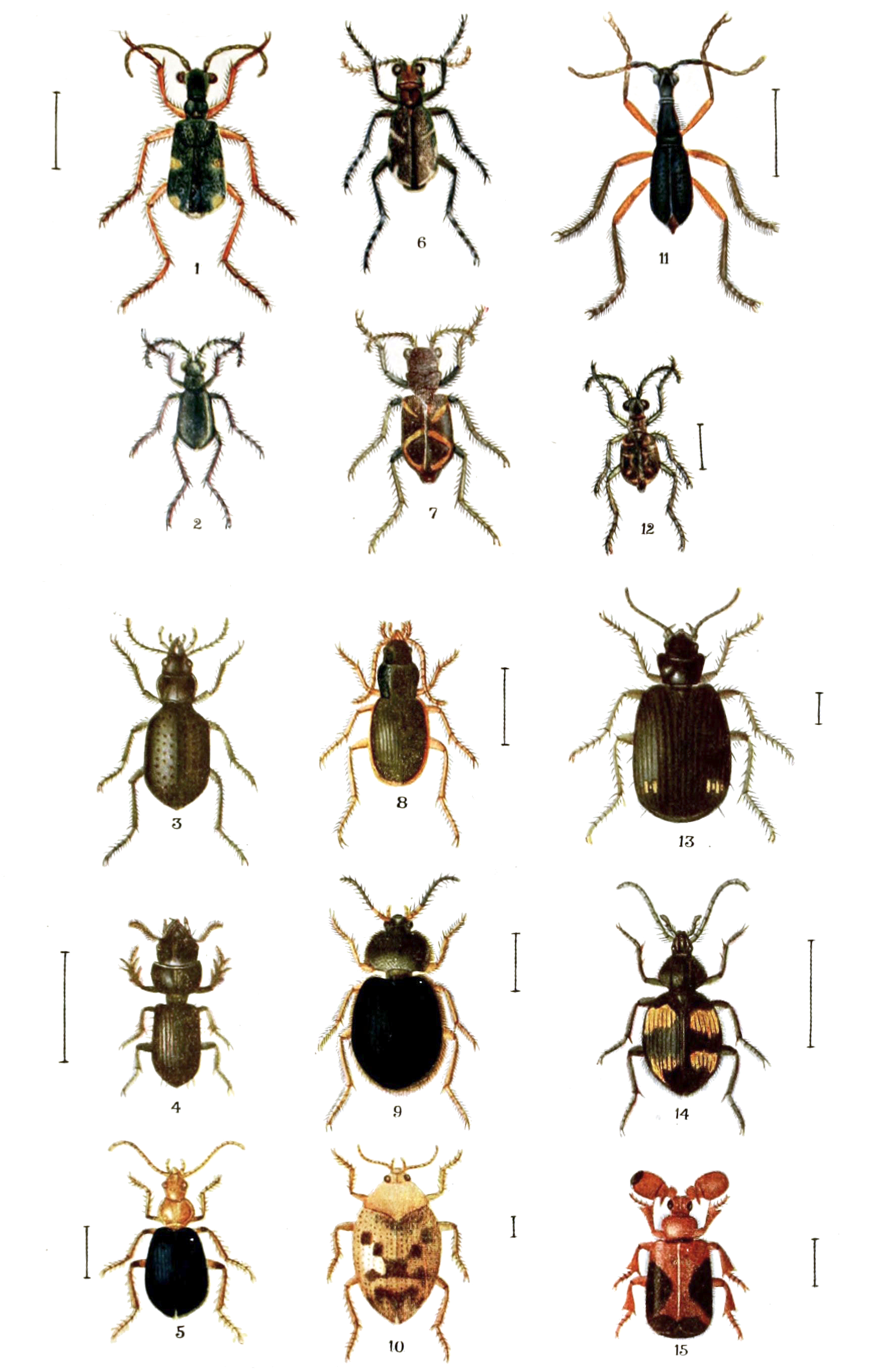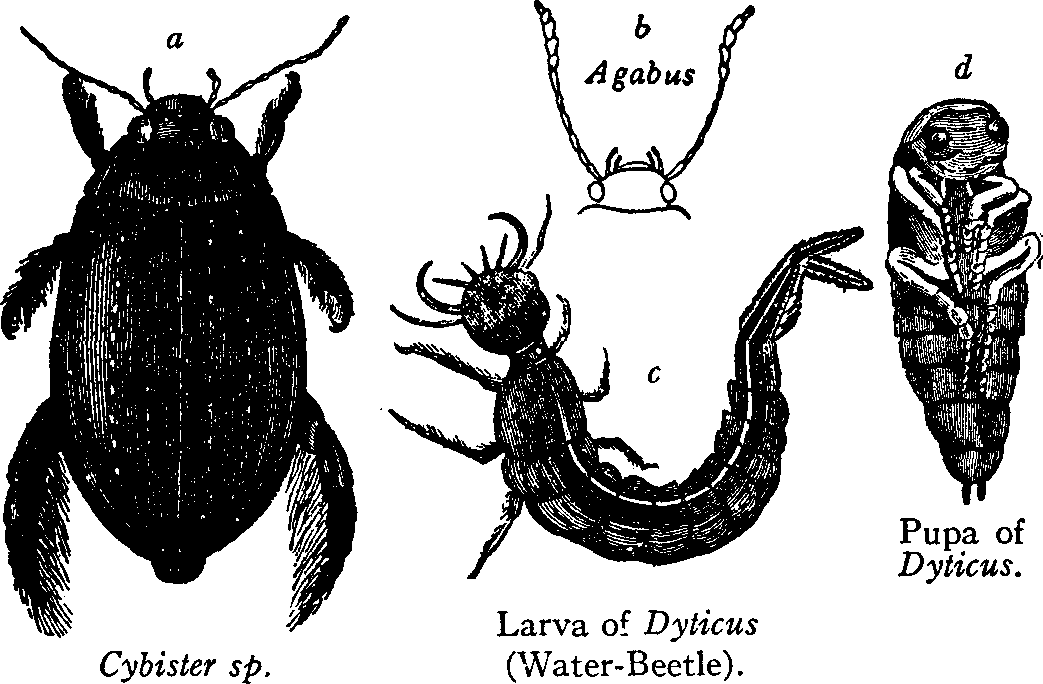|
Haliplidae
The Haliplidae are a family of water beetles that swim using an alternating motion of the legs. They are therefore clumsy in water (compared e.g. with the Dytiscidae or Hydrophilidae), and prefer to get around by crawling. The family consists of about 200 species in 5 genera, distributed wherever there is freshwater habitat; it is the only extant member of superfamily Haliploidea. They are also known as crawling water beetles or haliplids. Description The imagines of these beetles are generally oval in shape, with a very convex upperside, and are generally long. They are generally yellowish to light brown in color, frequently with light and dark patterns dotted with 10 or more rows of punctures on the elytra. The family's most distinctive characteristic is the large coxal plates of the hindlegs, which are immobile (though not fused in the centerline) and extend back along the underside to cover most of the abdomen base and the hindleg trochanters and femora. They are used as ai ... [...More Info...] [...Related Items...] OR: [Wikipedia] [Google] [Baidu] |
Algophilus
''Algophilus lathridioides'' is a species of beetles in the family Haliplidae, the only species in the genus ''Algophilus''. Its range includes parts of South Africa South Africa, officially the Republic of South Africa (RSA), is the southernmost country in Africa. It is bounded to the south by of coastline that stretch along the South Atlantic and Indian Oceans; to the north by the neighbouring countri .... References Haliplidae Monotypic Adephaga genera {{Haliplidae-stub ... [...More Info...] [...Related Items...] OR: [Wikipedia] [Google] [Baidu] |
Brychius
''Brychius'' is a genus of beetle Beetles are insects that form the order Coleoptera (), in the superorder Endopterygota. Their front pair of wings are hardened into wing-cases, elytra, distinguishing them from most other insects. The Coleoptera, with about 400,000 describ ...s in the family Haliplidae, containing the following species: * '' Brychius elevatus'' (Panzer, 1793) * '' Brychius glabratus'' (Villa & Villa, 1835) * '' Brychius hornii'' Crotch, 1873 * '' Brychius hungerfordi'' Spangler, 1954 * '' Brychius pacificus'' Carr, 1928 References Haliplidae Beetles described in 1859 {{Haliplidae-stub ... [...More Info...] [...Related Items...] OR: [Wikipedia] [Google] [Baidu] |
Cretihaliplus
''Cretihaliplus'' is a genus of beetle Beetles are insects that form the order Coleoptera (), in the superorder Endopterygota. Their front pair of wings are hardened into wing-cases, elytra, distinguishing them from most other insects. The Coleoptera, with about 400,000 describ ...s in the family Haliplidae, containing the following species: at Joel Hallan's Biology Catalog. Texas A&M University. Retrieved on 10 May 2012. * '' Cretihaliplus chifengensis'' Ren, Zhu & Lu, 1995 * '' Cretihaliplus sidaoj ... [...More Info...] [...Related Items...] OR: [Wikipedia] [Google] [Baidu] |
Haliplus
''Haliplus'' is a genus of crawling water beetles in the family Haliplidae. There are at least 180 described species in ''Haliplus''. They are found worldwide, except for Antarctica, living among algae and aquatic vegetation at edges of ponds, lakes, and streams. They range in size from 1.75 to 5 mm. Species These species are members of the genus ''Haliplus''. * '' Haliplus abbreviatus'' Wehncke, 1880 * '' Haliplus africanus'' Aubé, 1838 * '' Haliplus alastairi'' Watts, 1988 * '' Haliplus aliae'' Vondel, 2003 * '' Haliplus allisonae'' Brigham * '' Haliplus alluaudi'' Régimbart, 1903 * '' Haliplus andalusicus'' Wehncke, 1872 * '' Haliplus angusi'' Vondel, 1991 * '' Haliplus angustifrons'' Regimbart, 1892 * '' Haliplus annulatus'' Roberts, 1913 * ''Haliplus apicalis'' (Thomson) (saltmarsh crawler) * '' Haliplus apostolicus'' Wallis, 1933 * '' Haliplus arrowi'' Guignot, 1936 * ''Haliplus aspilus'' Guignot, 1957 * '' Haliplus astrakhanus'' Vondel, 1991 * ''Haliplus australis'' C ... [...More Info...] [...Related Items...] OR: [Wikipedia] [Google] [Baidu] |
Apteraliplus
''Apteraliplus'' is a genus of crawling water beetle The Haliplidae are a family of water beetles that swim using an alternating motion of the legs. They are therefore clumsy in water (compared e.g. with the Dytiscidae or Hydrophilidae), and prefer to get around by crawling. The family consists of ...s in the family Haliplidae. There is at least one described species in ''Apteraliplus'', ''A. parvulus'' (Roberts, 1913), the flightless haliplid beetle. at Joel Hallan's Biology Catalog. Texas A&M University. Retrieved on 10 May 2012. References Further reading * * * * Haliplidae[...More Info...] [...Related Items...] OR: [Wikipedia] [Google] [Baidu] |
Peltodytes
''Peltodytes'' is a genus of water beetle which is native to the Nearctic, Europe, the Near East, and North Africa North Africa, or Northern Africa is a region encompassing the northern portion of the African continent. There is no singularly accepted scope for the region, and it is sometimes defined as stretching from the Atlantic shores of Mauritania in .... ''Peltodytes'' can generally be differentiated from the similar '' Haliplus'' by the presence of a pair of spots on the posterior margin of the pronotum. The genus ''Peltodytes'' contains the following species: at Joel Hallan's Biology Catalog. Texas A&M University. Retrieved on 10 May 2012. * '' [...More Info...] [...Related Items...] OR: [Wikipedia] [Google] [Baidu] |
Adephaga
The Adephaga (from Greek ἀδηφάγος, ''adephagos'', "gluttonous") are a suborder of beetles, and with more than 40,000 recorded species in 10 families, the second-largest of the four beetle suborders. Members of this suborder are collectively known as adephagans. The largest family is Carabidae (ground beetles) which comprises most of the suborder with over 40,000 species. Adephaga also includes a variety of aquatic beetles, such as predaceous diving beetles and whirligig beetles. Anatomy Adephagans have simple antennae with no pectination or clubs. The galeae of the maxillae usually consist of two segments. Adult adephagans have visible notopleural sutures. The first visible abdominal sternum is completely separated by the hind coxae, which is one of the most easily recognizable traits of adephagans. Five segments are on each foot. Wings The transverse fold of the hind wing is near the wing tip. The median nervure ends at this fold, where it is joined by a cro ... [...More Info...] [...Related Items...] OR: [Wikipedia] [Google] [Baidu] |
Water Beetle
A water beetle is a generalized name for any beetle that is adapted to living in water at any point in its life cycle. Most water beetles can only live in fresh water, with a few Marine (ocean), marine species that live in the intertidal zone or littoral zone. There are approximately 2000 species of true water beetles native to lands throughout the world. Many water beetles carry an air bubble, called the elytra cavity, underneath their abdomens, which provides an air supply, and prevents water from getting into the Spiracle (arthropods), spiracles. Others have the surface of their exoskeleton modified to form a Gill#Plastrons, plastron, or "physical gill", which permits direct gas exchange with the water. Some families of water beetles have fringed hind legs adapted for swimming, but most do not. Most families of water beetles have larvae that are also aquatic; many have aquatic larvae and terrestrial adults. Diet Water beetles can be either herbivores, predators, or scavengers. ... [...More Info...] [...Related Items...] OR: [Wikipedia] [Google] [Baidu] |
Antenna (biology)
Antennae ( antenna), sometimes referred to as "feelers", are paired appendages used for sensing in arthropods. Antennae are connected to the first one or two segments of the arthropod head. They vary widely in form but are always made of one or more jointed segments. While they are typically sensory organs, the exact nature of what they sense and how they sense it is not the same in all groups. Functions may variously include sensing touch, air motion, heat, vibration (sound), and especially smell or taste. Antennae are sometimes modified for other purposes, such as mating, brooding, swimming, and even anchoring the arthropod to a substrate. Larval arthropods have antennae that differ from those of the adult. Many crustaceans, for example, have free-swimming larvae that use their antennae for swimming. Antennae can also locate other group members if the insect lives in a group, like the ant. The common ancestor of all arthropods likely had one pair of uniramous (unbranched ... [...More Info...] [...Related Items...] OR: [Wikipedia] [Google] [Baidu] |
Tree Of Life Web Project
The Tree of Life Web Project is an Internet project providing information about the diversity and phylogeny of life on Earth. This collaborative peer reviewed project began in 1995, and is written by biologists from around the world. The site has not been updated since 2011, however the pages are still accessible. The pages are linked hierarchically, in the form of the branching evolutionary tree of life, organized cladistically. Each page contains information about one particular group of organisms and is organized according to a branched tree-like form, thus showing hypothetical relationships between different groups of organisms. In 2009 the project ran into funding problems from the University of Arizona. Pages and Treehouses submitted took a considerably longer time to be approved as they were being reviewed by a small group of volunteers, and apparently, around 2011, all activities ended. History The idea of this project started in the late 1980s. David Maddison was wor ... [...More Info...] [...Related Items...] OR: [Wikipedia] [Google] [Baidu] |
Compound Eye
A compound eye is a visual organ found in arthropods such as insects and crustaceans. It may consist of thousands of ommatidia, which are tiny independent photoreception units that consist of a cornea, lens, and photoreceptor cells which distinguish brightness and color. The image perceived by this arthropod eye is a combination of inputs from the numerous ommatidia, which are oriented to point in slightly different directions. Compared with single-aperture eyes, compound eyes have poor image resolution; however, they possess a very large view angle and the ability to detect fast movement and, in some cases, the polarization of light. Because a compound eye is made up of a collection of ommatidia, each with its own lens, light will enter each ommatidium instead of using a single entrance point. The individual light receptors behind each lens are then turned on and off due to a series of changes in the light intensity during movement or when an object in moving, creating a flic ... [...More Info...] [...Related Items...] OR: [Wikipedia] [Google] [Baidu] |
Metasternum
The metathorax is the posterior of the three segments in the thorax of an insect, and bears the third pair of legs. Its principal sclerites ( exoskeletal plates) are the metanotum (dorsal), the metasternum (ventral), and the metapleuron (lateral) on each side. The metathorax is the segment that bears the hindwings in most winged insects, though sometimes these may be reduced or modified, as in the flies ( Diptera), in which they are reduced to form halteres, or flightless, as in beetles ( Coleoptera), in which they may be completely absent even though forewings are still present. All adult insects possess legs on the metathorax. In most groups of insects, the metanotum is reduced relative to the mesonotum. In the suborder Apocrita of the Hymenoptera, the first abdominal segment is fused to the metathorax, and is then called the propodeum. See also *Glossary of entomology terms *Insect morphology *Mesothorax *Prothorax *Thorax (insect anatomy) The thorax is the midsection ( tagma) ... [...More Info...] [...Related Items...] OR: [Wikipedia] [Google] [Baidu] |



